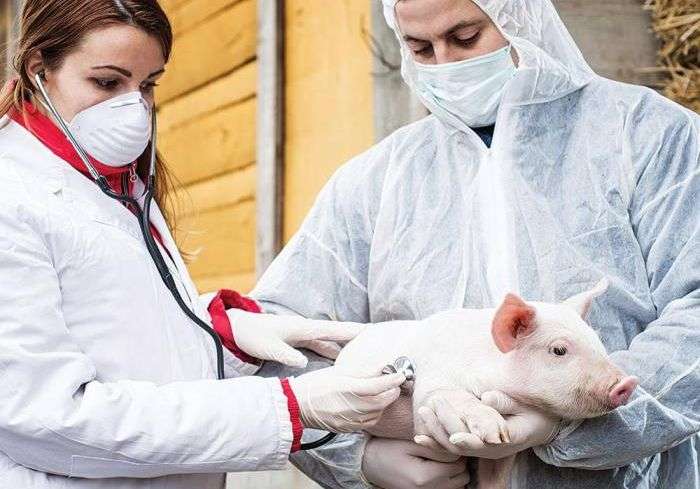Pigs can be susceptible to various diseases, just like any other animal. Here is a list of pig diseases, their causes, symptoms, and treatment methods.
Greasy Pig Disease (exudative epidermis)
Greasy pig disease is caused by an infection of the skin with a skin bacterium, Staphylococcus hyiens, and affects pigs from one to seven weeks of age.
There is scale-formation on the skin which gives rise to crusts, and the skin becomes greasy with matted hair.
There is no fever and your pigs would not scratch. In the early stages of the disease, you can confuse the condition with zinc deficiency.
There are effective medications for dipping infected pigs, combined with broad-spectrum antibiotic injections.
Porcine Parvovirus (PPV)
PPV is caused by Parvovirus. The symptoms of the disease are Infertility in sows, early embryonic death, and mummified fetuses.
Treatment: There is no specific treatment for PPV, however, vaccination of sows can prevent the disease.
Porcine Reproductive and Respiratory Syndrome (PRRS)
PRRS disease, popularly known as blue ear disease is caused by PRRS virus (PRRSV), an RNA virus.
Symptoms of blue ear disease include reproductive issues in sows, such as abortions and stillborn piglets, respiratory problems in young pigs, fever, lethargy, etc.
Treatment: There is no cure for PRRS, but supportive care can be provided.
Early vaccination can also help prevent the disease from affecting your swine.
Swine Fever (African Swine Fever, Classical Swine Fever)
This disease is caused by viral infection (African Swine Fever is caused by a large DNA virus, and Classical Swine Fever is caused by a Pestivirus).
The symptoms of this pig disease are high fever, loss of appetite, weakness, red or purple skin discoloration, diarrhea, and respiratory distress.
For treatment, there are no specific treatments or vaccines for these viral diseases.
In most cases, infected pigs are usually euthanized to prevent further spread to healthy pigs.
Swine Influenza
Cause: Influenza A virus.
Symptoms: Coughing, sneezing, fever, nasal discharge.
Treatment: Supportive care, isolation of infected pigs, and vaccination can help manage the disease.
Swine Dysentery
Cause: Bacteria, typically Brachyspira hyodysenteriae.
Symptoms: Bloody or mucoid diarrhea, weight loss, lethargy.
Treatment: Antibiotics like tiamulin and lincomycin can be used to treat affected pigs. Improved biosecurity and hygiene measures can help prevent spread.
Foot-and-mouth disease (FMD)
Cause: FMD virus (FMDV).
Symptoms: Fever, blisters on the feet, snout, and mouth, lameness.
Treatment: No specific treatment; infected pigs are usually culled to control outbreaks. Vaccination can be used as a preventive measure.
Erysipelas
Cause: Bacterium, Erysipelothrix rhusiopathiae.
Symptoms: Diamond-shaped skin lesions, fever, arthritis, and sudden death.
Treatment: Antibiotics like penicillin can effectively treat Erysipelas.
It’s important to note that proper biosecurity measures, vaccination, and regular health checks by a veterinarian can play a significant role in preventing the outbreak and spread of these diseases in pig populations.
If you suspect that your pigs are sick or showing signs of disease, seek immediate veterinary attention for proper diagnosis and treatment.
Mastitis-metritis-agalactia (MMA Syndrome)
This syndrome is a common problem, which results from a bacterial infection in the newly-farrowed sow and may occur as a single entity, or any of the three combined.
In sows infected with mastitis, the mammary glands become swollen and inflamed and this may or may not be associated with an infected uterus (metritis).
In either case, there is invariably a lack of milk flow (agalactia) and piglets will become thin and begin to die on the second or third day due to starvation.
Swine Influenza
Swine influenza is a highly contagious respiratory disease caused by an influenza virus.
It is normally triggered by stress, particularly rapid temperature changes.
Although mortality is low, the disease has important economic consequences due to stunting and reduced live weight gains.
The first sign of the disease is normally a cough, with a high temperature and loss of appetite.
The disease spreads rapidly, breathing becomes jerky and the hair coat develops a rough appearance.
Secondary infection with bacteria may complicate the condition. There is no treatment or preventive vaccine available.
Infection can be prevented by good management and the avoidance of stress.








